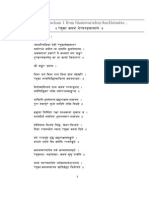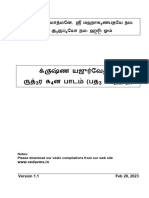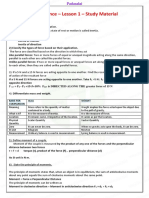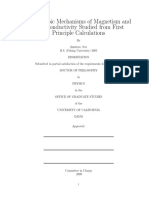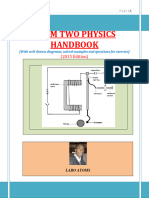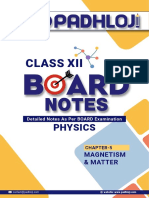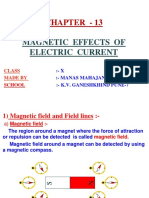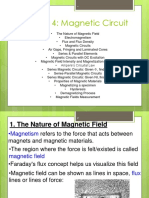100%(1)100% found this document useful (1 vote)
889 views6th STD Term 1 Science Book Back Questions With Answers in English
6th STD Term 1 Science Book Back Questions With Answers in English
Uploaded by
Jaya KumarThis document contains science questions and answers from a 6th standard textbook covering topics about plants and food habits. It includes multiple choice questions, matching questions, fill in the blank questions, true/false questions and short answer questions. The questions test knowledge about plant parts and their uses, medicinal plants, nutrition, food groups, deficiency diseases and more. Sample questions include identifying plants used for food or medicine, matching plants to their uses, naming deficiency diseases and stating whether sentences are true or false.
Copyright:
© All Rights Reserved
Available Formats
Download as PDF, TXT or read online from Scribd
6th STD Term 1 Science Book Back Questions With Answers in English
6th STD Term 1 Science Book Back Questions With Answers in English
Uploaded by
Jaya Kumar100%(1)100% found this document useful (1 vote)
889 views28 pagesThis document contains science questions and answers from a 6th standard textbook covering topics about plants and food habits. It includes multiple choice questions, matching questions, fill in the blank questions, true/false questions and short answer questions. The questions test knowledge about plant parts and their uses, medicinal plants, nutrition, food groups, deficiency diseases and more. Sample questions include identifying plants used for food or medicine, matching plants to their uses, naming deficiency diseases and stating whether sentences are true or false.
Original Description:
Science school guide
Original Title
6th Std Term 1 Science Book Back Questions With Answers in English
Copyright
© © All Rights Reserved
Available Formats
PDF, TXT or read online from Scribd
Share this document
Did you find this document useful?
Is this content inappropriate?
This document contains science questions and answers from a 6th standard textbook covering topics about plants and food habits. It includes multiple choice questions, matching questions, fill in the blank questions, true/false questions and short answer questions. The questions test knowledge about plant parts and their uses, medicinal plants, nutrition, food groups, deficiency diseases and more. Sample questions include identifying plants used for food or medicine, matching plants to their uses, naming deficiency diseases and stating whether sentences are true or false.
Copyright:
© All Rights Reserved
Available Formats
Download as PDF, TXT or read online from Scribd
Download as pdf or txt
100%(1)100% found this document useful (1 vote)
889 views28 pages6th STD Term 1 Science Book Back Questions With Answers in English
6th STD Term 1 Science Book Back Questions With Answers in English
Uploaded by
Jaya KumarThis document contains science questions and answers from a 6th standard textbook covering topics about plants and food habits. It includes multiple choice questions, matching questions, fill in the blank questions, true/false questions and short answer questions. The questions test knowledge about plant parts and their uses, medicinal plants, nutrition, food groups, deficiency diseases and more. Sample questions include identifying plants used for food or medicine, matching plants to their uses, naming deficiency diseases and stating whether sentences are true or false.
Copyright:
© All Rights Reserved
Available Formats
Download as PDF, TXT or read online from Scribd
Download as pdf or txt
You are on page 1of 28
6th Science Book Back Questions With Answers in English
More Book Back Questions Check here - https://goo.gl/rSCNT8
6th Std Term - I
1. The World of Plants
I. Choose the correct answer:
1. Plants with medical value are called
(a) pulses (b) scented plants
(c) medical plants (d) barks
2. Of the following, which is the seed part of the plant used of food.
(a) thoor dhal (b) veldt grape
(c) banana (d) turmeric
3. Select the food-related industry from the following:
(a) coir making (b)gardening
(c) cotton cultivation (d) pickle-making
4. Name the unripe fruit that we have to consume for blood purification.
(a) gooseberry (b) neem
(c) veldt grape (d) carry me seed
5. Name the tree used in paper industry.
(a) Teak (b) Eucalyptus
(c) Coconut tree (d) Sandalwood tree
6. Which of the following is the stem part of the plant used as food item?
(a) Chilli (b) Drumstick
(c) Turmeric (d) Thoor dhal
7. Which of the following hrbal plants is used to cures jaundice?
(a) Keeezhanelli (b) Thulsi
(c) Vasambu (d) Manjal
8. Which of the following is the main source of Vitamin ‘C’?
1 www.winmeen.com | Learning Leads to Ruling
6th Science Book Back Questions With Answers in English
More Book Back Questions Check here - https://goo.gl/rSCNT8
(a) Manjal (b) Brinjal
(c) Vembu (d) Nelli
9. ……. are made from Mulberry tree.
(a) Cricket bats (b) Match sticks
(c) Hockey sticks (d) Railway sleepers
10. Which of the following does not catch fire easily?
(a) Sandal (b) Vembu
(c) Teak (d) Red wood
11. Kumbakonam is popular for…..
(a) Jasmine (b) Sugarcane
(c) Betel leaves (d) Mango
12. Bed and pillows are made from….
(a) Sandal tree (b) Coconut tree
(c) Silk cotton tree (d) Pine tree
13. The other name of Keezhanelli is….
(a) Omavalli (b) Carry me seed
(c) Purple fruited egg plant (d) Vembu
14. Which of the following is used to regulate the body temperature?
(a) Nelli (b) Vasambu
(c) Manjal (d) Pirandai
15. Which one of the following trees yields fruits for about 400 years?
(a) Mango (b) Banana
(c) Jack fruit (d) Orange
II. Match the following:
2 www.winmeen.com | Learning Leads to Ruling
6th Science Book Back Questions With Answers in English
More Book Back Questions Check here - https://goo.gl/rSCNT8
A. Trees Uses
1. Eucalyptus a. Parts of bullock cart
2. Silk cotton b. Railway sleepers
3. Coconut c. Tennis racket and Hockey stick
4. Mulberry d. Thatching, construction
5. Pine e. Match box
6. Babul bark tree f. Oil, papers
Ans: 1-f, 2-e,3-d, 4-c, 5-b, 6-a
B.
1. Carry me seed a. Treatment for digestive disorder
2. Ginger b. Abdominal diseases
3. Pepper c. Jaundice
4. Sweet flag d. Fever
5. Country borage e. Throat infection
Ans: 1-c,2-a,3-e,4-b,5-d
C.
1. Teak a. Oil, paper
2. Silk cotton b. Construction materials
3. Eucaluptus c. Cricket bat
4. Pine d. Match box
5. Willow e. Ship building
Ans: 1-b,2-d,3-a,4-e,5-c
D.
1. Ginger a. Cosmetic
2. Rose b. Tanjore
3 www.winmeen.com | Learning Leads to Ruling
6th Science Book Back Questions With Answers in English
More Book Back Questions Check here - https://goo.gl/rSCNT8
3. Paddy c. Herbal plant
4. Jasmine d. Zimbabwe
5. Baobab tree e. Madurai
Ans: 1-c,2-a,3-b,4-e,5-d
III. Fill in the blanks:
1. Carry mee seed (Keezhanelli) cures_________
Ans: Jaundice
2. Peppers cures _____
Ans: Throat infection
3. ______ are used in the preparation of cosmetics.
Ans: flowers
4. ______ used as germicide and cosmetic.
Ans: Turmeric
5. _____ State is known as Garden of Spices of India.
Ans: Kerala
6. Jute fibre is obtained from the _____ of plant.
Ans: Stem
7. The soft, outer region of the stem is called as ______.
Ans: sap wood
8. _____ wood is used for building purposes.
Ans: Heart wood
9. Fibers obtained from the outer regon of the cotton, coconut are known as ___.
Ans: External fibers
10. _____ cures mouth ulcer.
Ans: Gooseberry
4 www.winmeen.com | Learning Leads to Ruling
6th Science Book Back Questions With Answers in English
More Book Back Questions Check here - https://goo.gl/rSCNT8
11.______ is used as germicide and as cosmetic.
Ans: Turmeric
12. Tennis and Hockey sticks are made from____ tree.
Ans: Mulberry
13. The thickest Baobab tree is found in _______.
Ans: Zimbabwe
14. The main source of vitamin ‘C’ is____
Ans: Gooseberry
15. Agriculture is a branch of ______
Ans: Science
16. ______ is used to cure cold, cough and fever.
Ans: Thulsi
17. _____ play a key role in the preparation of cosmetics.
Ans: Flowers
18. Long, thin, strong, strand obtained from plants is known as _____
Ans: fibre
19. The dark inner region of the stem is called ____
Ans: heartwood
20. ______ cures mouth ulcer, regulates body temperature .
Ans: Gooseberry
21. _____ give good smell and colour to food.
Ans: Spices
22. ______ are used as medicians for common cold, fever and stomach ache.
Ans: Holy basiland ginger
IV. Answer the following questions in one or single world.
5 www.winmeen.com | Learning Leads to Ruling
6th Science Book Back Questions With Answers in English
More Book Back Questions Check here - https://goo.gl/rSCNT8
1. What is the common name of Country borage?
Ans: Karpuravalli
2. Name the herbal plant used to increase the appetite.
Ans: Pirandai
3. What is botany?
Ans:Science that deals with study of herbs, shrubs, climbers and trees.
4. Name the tree that is used in making parts of bullock cart.
Ans: Babul bark tree
5. Which herbal plant is used to destroy intestinal worms?
Ans: Vembu
6. Which part of the plant is used in chilliand drumstick?
Ans: Unripe fruit
7. Name two plants yielding stem fibers.
Ans: Plantain and jute
8. Name a tree used for making Railway sleepers.
Ans: Pine
9. Which tree yiels fibres for making coir?
Ans: Coconut tree
V. State whether the following sentences are true or false.
1. Purple fruited pea egg plant is used as medicine for jaundice.
Ans: False. Pea egg plant is used as medicine for cold and cough and “carry me
seed” is used for jaundice.
2. Ginger is the root of the plant.
Ans: False. Ginger is the stem of the plant
3. Veldt grape is a medicinal plant.
6 www.winmeen.com | Learning Leads to Ruling
6th Science Book Back Questions With Answers in English
More Book Back Questions Check here - https://goo.gl/rSCNT8
Ans: True
4. Clove is the seed of the plant.
Ans: False. Clove is the “ flower bud” of the plant.
5. Slik-cotton tree is used to make match box.
Ans: True
2. Food Habits
I. Fill in the blanks.
1. Disease caused due to protein deficiency is _____
Ans: Marasmus
2. Deficiency of Vitamin C causes _____.
Ans: Scurvy
3. _______ is an omnivore.
Ans: Crow
4. Milk is rich in _______ .
Ans: Calcium
5. _______ regulate the physiological activities.
Ans: Minerals
6. ______ is used to strengthen the bone.
Ans: Calcium
7. ________ is saprophytic in nutrition.
Ans: Mushroom
8. Anaemia is caused due to deficiency of _____ .
Ans: Iron
9. ___ is synthesized by the skin with the help of sunlight.
Ans: Vitamin D
7 www.winmeen.com | Learning Leads to Ruling
6th Science Book Back Questions With Answers in English
More Book Back Questions Check here - https://goo.gl/rSCNT8
10. Rickets is a ____ deficiency disease.
Ans: Vitamin D
11. The constituents of food which are essential for the body are called _____
Ans: Nutrients
12. Deficiency of iron leeds to____.
Ans: Aneamia
13. The deficiency disease of Vitamin B1 is _____
Ans: Beri-beri
14. Enlarged head, loss of weight and retarded growth are the symptoms of _____.
Ans: Marasmus
15. Bleeding gums is the symptom of the disease _____.
Ans: Scurvy
16. Preparation of starch by the plants with help of sunlight, CO2, water and
chlorophyll is called_____
Ans: Photosynthesis
17. Nepenthes is an _____ plant.
Ans: insectivorous.
18. ________ and ______ rich in ascorbic acid prevent heart diseases.
Ans: Steamed fish , Brinjal
19. Cockroach is a/an ______animal.
Ans: Omnivorous.
20. The organism that decomposs the dead plant and animal substances and
converts them into simple molecules and absorbs them through its body
wall_____.
Ans: Mushroom
21. ________ lives inside the body gut.
8 www.winmeen.com | Learning Leads to Ruling
6th Science Book Back Questions With Answers in English
More Book Back Questions Check here - https://goo.gl/rSCNT8
Ans: Roundworm
22. Animals which feed only on plants are called_____.
Ans: herbivores
23. Head louse and leech are examples of_______.
Ans: ectoparasite
24. Loss of excessive blood even for a small hurt is the symptom of _______
deficiency.
Ans: Vitamin K
25. Inflammation in neck is the symptom of ________.
Ans: Goitre
II. Choose the correct answer:
1. Which one of the following energy?
(a) Fat (b) Vitamins
(c) Minerals (d) Water
2. Which of the following at as regulators in physiological activities?
(a) Proteins (b) Fats
(c) Carbohydrates (d) Minerals
3. ________ help in growth of the body.
(a) Vitamins (b) Water
(c) Proteins (d) Fat
4. Which of the following has the maximum water content?
(a) Bread slice (b) Milk
(c) Egg (d) Cucumber
5. The disease caused by deficiency of protein is______
(a) Night-blindness (b) Beri-beri
9 www.winmeen.com | Learning Leads to Ruling
6th Science Book Back Questions With Answers in English
More Book Back Questions Check here - https://goo.gl/rSCNT8
(c) Marasmus (d) Rickets
6. Which one of the following is the disease caused by deficiency of Vutamin ‘C’?
(a) Kwashiorkar (b) Scurvy
(c) Rickets (d) Bery-bery
7. Goitre is due to the deficiency of_______.
(a) Vitamin A (b) Vitamin C
(c) Iodine (d) Iron
8. Night-blindness is due to the deficiency of_____.
(a) Iodine (b) Iron
(c) Vitamin C (d) Vitamin A
9. Which of the following caused by deficiency of Vitamin D?
(a) Rickets (b) Goitre
(c) Anaemia (d) Scurvy
10. which of the following adopts autotrophic nutrition?
(a) Cuscuta (b) Roundworm
(c) Green plants (d) Leech
11. Roundworm is an_______.
(a) Ectoparasite (b) Endoparasite
(c) Saprophyte (d) nsectivorous
12. ______ is an omnivore.
(a) Goat (b) Cattle
(c) Tiger (d) Crow
13. An example for an insectivorous plant is______
(a) Hibiscus (b) Drosera
(c) Cuscuta (d) Green plants
10 www.winmeen.com | Learning Leads to Ruling
6th Science Book Back Questions With Answers in English
More Book Back Questions Check here - https://goo.gl/rSCNT8
14. Animals which feed only on plants are called_____
(a) Omnivorous (b) Herbivorous
(c) Carnivorous (d) Insectivorous
III. Match the following.
A.
1. Vitamin A a. Kwashiorkar
2. Vitamin C b. Aneamia
3. Vitamin D c. Night-blindness
4. Protein deficiency d. Scurvy
5. Iron deficiency e. Rickets
Ans: 1-c,2-d,3-e,4-a,5-b
B.
1. Herbivorous a. Tiger
2. Carnivorous b. Cow
3. Omnivorous c. Nephenthes
4. Insectivorous d. Leech
5. Ectoparasite e. Monkey
Ans: 1-b,2-a,3-e,4-c,5-d
IV. Answer the following in one or two words:
1. Which nutrient acts as regulator in physiological activities?
Ans: Minerals
2. What is the deficiency disease of iodine?
Ans: Goitre
3. What is the percentage of water content in potato?
Ans: about 75%
11 www.winmeen.com | Learning Leads to Ruling
6th Science Book Back Questions With Answers in English
More Book Back Questions Check here - https://goo.gl/rSCNT8
4. Which vegetable is rich in ascorbic acid?
Ans: Brinjal
5. Name one fibre food.
Ans: Beans
6. What are the two types of parasites?
Ans: (a) Ectoparasites (b) Endoparasites
7. Which age group of children suffer from Kwashiorkar?
Ans: 1-5 years
3. Changes Around Us
I. Choose the correct answer:
1. Release of the compressed spring is_____
(a) an irreversible change (b) a reversible change
(c) a non-periodic change (d) an undesirable change
2. Spoilage of food is______
(a) a reversible change (b) a fast change
(c) an undesirable change (d) a periodic change
3. Dissolution of washing soda in water is______
(a) an exothermic change (b) an irreversible change
(c) an undesirable change (d) an endothermic change
4. Which of the following changes is non-periodic?
(a) heartbeat (b) earthwuake
(c) occurance of day and night (d) oscillation of pendulum
5. Who was the first Indian woman travelled to the space?
(a) Marie Curie (b) Indira Nooyee
(c) Kalpana Chawla (d) Saira
12 www.winmeen.com | Learning Leads to Ruling
6th Science Book Back Questions With Answers in English
More Book Back Questions Check here - https://goo.gl/rSCNT8
6. Which of the following statement is correct?
(a) Our body loses weight in space (b) Ourbody gains weight in space
(c) Our eye sight becomes dull (d) All are correct
7. The time taken for a tree to turn into coal under the earth is______.
(a) 34 years (b) 3400 years
(c) 34000 years (d) 30 crore years
8. Which of the following is a slow change?
(a) Burning of paper (b) Brusting of crackers
(c) Rusting of iron (d) Glowing of electric bulb
9. Which of the following is a fast change?
(a) Growth of a child (b) Brustin of crackers
(c) Germination of seed (d) Curdling of milk
10. Which of the following is a reversible change?
(a) Batter into idly (b) Green vegetables into cooked food
(c) Making of ornaments from gold (d) Curdling of milk
11. Which of the following is an irreversible change?
(a) Evaporation of water (b) Melting of ice
(c) Making ornaments from silver (d) Ripening of fruits
12. Which of the following is a desirable change?
(a) Earthwuake (b) Accident
(c) Blooming of volcano (d) Landslide
13. Which of the following is a periodical change?
(a) Heart beat (b) Earthquake
(c) Eruption of volcano (d) Landslide
14. Which of the following is a non-periodical change?
13 www.winmeen.com | Learning Leads to Ruling
6th Science Book Back Questions With Answers in English
More Book Back Questions Check here - https://goo.gl/rSCNT8
(a) `Oscillation of pendulum (b) Phases of moon
(c) Occurrence of day and night (d) Earthquake
15. The reactions in which heat is liberated are called ____ reactions.
(a) Endothermic (b) Exothermic
(c) Adiabatic (d) Isothermic
16. The reactions in which heat is absorbed are called ____ reactions.
(a) Endothermic (b) Exothermic
(c) Adiabatic (d) Isothermic
17. In some changes, the substance can be brought back to its original state. Such
changes are called _____ changes.
(a) Periodic (b) Non-periodic
(c) Undesirable (d) Reversible
18. Changes that are useful are called ____changes.
(a) Undesirable (b) Desirable
(c) Periodic (d) Irreversible
19. Dissolution of glucose in water is an example of_______ reaction.
(a) Adiabatic (b) Isothermal
(c) Edothermic (d) Exothermic
20. When Ammonium chloride is dissolved in water _____ is absorbed.
(a) Mass (b) Heat
(c) Time (d) Salt
21. Dissolution of quick lime in water is an example of _______ reaction.
(a) Exothermic (b) Endothermic
(c) Isochronous (d) Isobaric
22. Dissolution of detergent powder in water is an example of _____ reaction.
14 www.winmeen.com | Learning Leads to Ruling
6th Science Book Back Questions With Answers in English
More Book Back Questions Check here - https://goo.gl/rSCNT8
(a) Exothermic (b) Endothermic
(c) Isochronous (d) Isobaric
II. Fill in the blanks.
1. Curdling of milk is an ______ change.
Ans: irreversible
2. Ripening of fruit is ______ change.
Ans: desirable irreversible
3. Burning of paper is a________ change.
Ans: fast
4.Melting of ice is a/an ________ change.
Ans: reversible
5. Seasonal changes are _________ changes.
Ans: periodic
6. Eruption of volcano is _____change.
Ans: non-periodic
7. When detergent powder is dissolved in water, heat is______
Ans: liberated
8. When glucose is dissolved in water, heat is ______
Ans: absorbed
9. Germination of seed is ____
Ans: slow change
10. Burning of paper is _______
Ans: fast change
11. Kalpana Chawla was the _______ who travelled to the space.
15 www.winmeen.com | Learning Leads to Ruling
6th Science Book Back Questions With Answers in English
More Book Back Questions Check here - https://goo.gl/rSCNT8
Ans: first Indian woman
12. She went round the world within _____
Ans: one and half hours
13. Useful changes are called ______
Ans: desirable changes
14. Velco was invented in the year _____
Ans: 1948
15. Velco is widely used in _______
Ans: foot wear
16. Dissolution of glucose is an ______
Ans: endothermic
17. Trees which are buried under the earth are turned into _____
Ans: coal
18. Release of compressed spring is _______
Ans: reversible
III. Match the following
1.
1. Burning of paper a. Desirable change
2. Rusting of iron b. Reversible change
3. Melting of ice c. Slow change
4. Ripening of fruits d. fast change
Ans: 1-d,2-c,3-b,4-a
2.
1. Melting of Gold a. Reversible change
2. Melting of Tar b. Irreversible change
16 www.winmeen.com | Learning Leads to Ruling
6th Science Book Back Questions With Answers in English
More Book Back Questions Check here - https://goo.gl/rSCNT8
3. The batter from Idly or dosa c. Undesirable change
4. Eruption of volcano d. Reversible change
Ans: 1-a,2-d,3-b,4-c
3.
1. Earth quake a. Endothermic changes
2. Weather b. Non-periodic changes
3. Buring of match stick c. Periodic changes
4. Dissolution of glucose d. Exothermic changes
Ans: 1-b,2-c,3-d,4-a
4.
1. Full moon and New moon a. Exothermic changes
2. Weather b. Endothermic changes
3. Buring of match stick c. Periodic changes
4. Dissolution of glucose d. Periodic changes
Ans: 1-c,2-d,3-a,4-b
4. Measurement and Motion
I. Choose the correct answer.
1. SI unit of length is_____
(a) centimetre (b) millimetre
(c) metre (d) kilometre
2. The symbol for SI unit of mass is___
(a) g (b) kg
(c) mg (d) cg
3. 1 metric tonne is equal to_____
(a) 1000 kilograms (b) 100 kilograms
17 www.winmeen.com | Learning Leads to Ruling
6th Science Book Back Questions With Answers in English
More Book Back Questions Check here - https://goo.gl/rSCNT8
(c) 1 kilogram (d) 10 kilograms
4. SI unit of time is____
(a) second (b) minute
(c) week (d) day
5. 1 hour=_____ seconds
(a) 60 (b) 3600
(c) 24 (d) 1000
6. Movement of a branch of a tree in air an example for_____
(a) Linear motion (b) Circular motion
(c) Periodic motion (d) Rotational motion
7. The motion of a rolling ball is _______ motion.
(a) Circular (b) Linear
(c) Rotational (d) Multiple
8. When a bicycle is in motion, the mouth which is used to fill the air will perform
_______
(a) Random motion (b) Periodic motion
(c) Circular motion (d) All of these
9. The vegetables are weighed with the help of a_____
(a) scale (b) balance
(c) measuring jar (d) watch clock
10. Which one of the following is not the unit of length?
(a) Hands pan (b) Metre
(c) Kilometre (d) kilogram
11. 1kilometre is equal to _____
(a) 10000 millimetre (b) 10 metre
18 www.winmeen.com | Learning Leads to Ruling
6th Science Book Back Questions With Answers in English
More Book Back Questions Check here - https://goo.gl/rSCNT8
(c) 1000 metre (d) 100 metre
12. ______ days are equal to one year.
(a) 24 (b) 365
(c) 1000 (d) 3600
13. Which of the following system is accepted as international standard system?
(a) CGS (b) F P S
(c) M K S (d) S I
14. 100kilogram is equal to____
(a) 1 metric tonne (b) 1 quintal
(c) 1 tonne (d) 1000 milligram
15. Which one of the following is used to measure liquids?
(a) Litre (b) Second
(c) Micro second (d) Hands pan
16. Which one of the following is a linear motion?
(a) Motion of cycle wheel (b)Motion of a lift
(c) Rolling ball (d) Drilling machine
17. The motion of a drilling machine is _____
(a) circular (b) linear
(c) circular and linear (d) oscillatory
II. Fill in the blanks.
1. One metre = 100 centimetre
2. One kilometre= 1000 metre
3. One quintal = 100 kilogram
4. One minute = 60 seconds
19 www.winmeen.com | Learning Leads to Ruling
6th Science Book Back Questions With Answers in English
More Book Back Questions Check here - https://goo.gl/rSCNT8
5. The mass of gold is measured by the unit _____
Ans: gram
6. Rice, sugar etc are measured by the unit_____
Ans: kilogram
7. Generally sugarcane is weighted by the unit _____
Ans: tonne
8. The mass of the chemicals present in a tablet are expressed in the unit____
Ans: milligram
9. Many physical quantities have both ______ and ______.
Ans: magnitude, unit
10. ________ is the multiple unit of length.
Ans: Kilometre
11. The mass of a body is the amount of ______ contained in it.
Ans: matter
12. For measuring time accurately, nowadays we use _____ and ______.
Ans: electronic, atomic clock
13. Motion of the moon around the earth is _______ motion.
Ans: rotational
14. _____ is defined as the change of position of an object with respect to time.
Ans: Motion
15. Centimetre, gram, second is called___ system of units.
Ans: CGS
16. Centimetre, millimetre are called _______ of metre.
Ans: submultiples
17. ____ is defined as the interval between two events.
20 www.winmeen.com | Learning Leads to Ruling
6th Science Book Back Questions With Answers in English
More Book Back Questions Check here - https://goo.gl/rSCNT8
Ans: Time
18. Motion of a body dropped from the top of the building is_____ motion.
Ans: linear
19. ______is called as Father of Robot.
Ans: Issac Asimov
20. Robot is a______
Ans: human machine
III.Match the following.
1.
1. Thickness of a five rupee coin a. Kilometre
2. Breadth of a classroom b. centimetre
3. Distance between two places c. millimetre
4. Height of your friend d. metre
Ans: 1-c,2-d,3-a,4-b
2.
1. mass a. 1 kilometre
2. length b. 1 metric tonne
3. time c. kilogram
4. 1000 m d. metre
5. 1000 kg e. second
Ans: 1-c,2-d,3-e,4-a,5-b
IV. Answer the following in one or two words.
1. What is the device used to measure time accurately?
Ans: Atomic clock
2. Define time.
21 www.winmeen.com | Learning Leads to Ruling
6th Science Book Back Questions With Answers in English
More Book Back Questions Check here - https://goo.gl/rSCNT8
Ans: Time is defined as the interval between two events.
3. What is length?
Ans: The distance between any two points.
4. Name the various units of mass.
Ans: Gram, kilogram, quintal and metric tonne.
5. Mention any two tools to measure length.
Ans: Tape, metre scale
6. What are the balance used to measure mass?
Ans: (a) Beam balance (b) Physical balance (c) Electronic balance.
7. Give an example of rotational motion.
Ans: Motion of a spinning top.
5. Magnetism
I. Choose the correct answer.
1. It is a natural magnet.
(a) Bar magnet (b) Magnetite
(c) Ring magnet (d) Horse-shoe magnet
2. An object that is attracted by magnet.
(a) Wooden piece (b) Plain pins
(c) Eraser (d) A piece of paper
3. The people who made mariner’s compass for the first time.
(a) Indians (b) Europeans
(c) Chinese (d) Egyptians
4. A freely suspended magnet always comes to rest in the ______ direction.
(a) North-east (b) South-west
(c) East-west (d) North-south
22 www.winmeen.com | Learning Leads to Ruling
6th Science Book Back Questions With Answers in English
More Book Back Questions Check here - https://goo.gl/rSCNT8
5. Magnets lose their properties when they are
(a) used (b) stored
(c) hit with a hammer (d) cleaned
6. Mariner’s compass is used to find the
(a) speed (b) displacement
(c) direction (d) motion
7. Which of the following is used in lifts and escalators?
(a) Iron rod (b) Temporary magnet
(c) Electromagnet (d) Bar magnet
8. In which of the following electromagnets are used?
(a) Flying trains (b) Lifts
(c) Escalators (d) All the these
9. Which of the following is attracted by magnets?
(a) Paper (b) Nail
(c) Wooden scale (d) Plastic scale
10. Which of the following is not attracted by the magnet?
(a) Iron ball (b) Nail
(c) Chalk piece (d) Blade
11. Which one of the following principles is used in an electromagnetic train?
(a) Magnetic attraction and repulsion
(b) Forces of induction
(c) Vanderwaal’s force
(d) Dipole-Dipole attracrtion
12. The natural magnet was discovered by____
(a) Magnes (b) Thomas
23 www.winmeen.com | Learning Leads to Ruling
6th Science Book Back Questions With Answers in English
More Book Back Questions Check here - https://goo.gl/rSCNT8
(c) Magnesia (d) Robert Hooke
13. Which of the following is called natural magnet?
(a) Pyrolusite (b) Magnesite
(c) Magnesite (d) Magnesium sulphate
14. Which of the following is the characteristic property of natural magnet?
(a) They do not have definite shape
(b) They have definite shape
(c) They come to rest in east-west direction
(d) All the above
15. Natural magnets are otherwise called______
(a) bar magnet (b) lode stones
(c) electromagnet (d) ring magnet
16. Which one of the following is the shape of the natural magnet?
(a) Ring (b) Horse shoe
(c) Shapeless (d) Bar
17. Which of the following is the characteristic of an electromagnetic train?
(a) Do not have wheels (b) Runs faster than ordinary train
(c) Does not make noise (d) All the above
18. Electromagnetic trains are called suspension trains since they run_____
(a) on tracks (b) with high speed
(c) without touching the rails (d) by electricity
19. Cranes are used to lift heavy load with the help of_____
(a) bar magnet (b) powerful electromagnet
(c) horse shoe magnet (d) ring magnet
20. Which of the following is attached to the pin holder and the refrigerator?
24 www.winmeen.com | Learning Leads to Ruling
6th Science Book Back Questions With Answers in English
More Book Back Questions Check here - https://goo.gl/rSCNT8
(a) Magnet (b) Magnesium
(c) Copper (d) Silver
21. Which of the following attracts more iron fillings?
(a) Bar magnet (b) Horse shoe magnet
(c) Temporary magnet (d) Iron rod
22.The place at which the attractive force is more in a magnet is_____
(a) poles (b) centre
(c) entire surface (d) a midpoint
23. When two north poles of two bar magnets are brought closer there will
be_____
(a) attraction (b) repulsion
(c) collision (d) none of these
24. When a North pole and South pole are brought closer, they show____
(a) attraction (b) repulsion
(c) move away from each other (d) all of these
25. Electromagnetic train is also called______
(a) electric train (b)ordinary train
(c) flying train (d) slow train
II. Fill in the blanks.
1. ______ are used to operate electromagnetic trains, lift and escalators.
Ans: Powerful electromagnets
2. Natural magnets are called _____ stones.
Ans: magnetic
3. The two ends of a magnet where the attractive force is more are called_____
Ans: poles
25 www.winmeen.com | Learning Leads to Ruling
6th Science Book Back Questions With Answers in English
More Book Back Questions Check here - https://goo.gl/rSCNT8
4. Powerful magnets are used to operate electromagnetic trains, lifts and _______
Ans: escalators
5. Natural magnets come to rest in _____ direction.
Ans: north-south
6. The substances that are not attracted by a magnet are called _______
Ans: non-magnetic
7. The attractive force is more at the _____ of the magnet.
Ans: poles
8. _____magnet attracts more iron filings at the two ends.
Ans: Horse shoe
9. _____ poles attract each other.
Ans: Unlike
10. The change in _______ pushes and pulls the electromagnetic train.
Ans: polarity
11. Electromagnetic train is also called ______train.
Ans: flying (or) suspension
12. Magnetites are the ______
Ans: natural magnet
13. Earth behaves like a _______
Ans: giant magnet
14. Electromagnetic train does not reuire______
Ans: Petrol
15. The electric current that changes constantly allows a change in ______ of
electromagnets.
Ans: polarity
26 www.winmeen.com | Learning Leads to Ruling
6th Science Book Back Questions With Answers in English
More Book Back Questions Check here - https://goo.gl/rSCNT8
16. For _______magnet one should keep a piece of iron across the poles.
Ans: horse shoe
17. ________ proposed that earth behaves like a giant magnet.
Ans: William Gilbert
III. Match the following
1.
1. Magnes a. Chinese
2. Plastic scale b. Natural magnet
3. Nail c. Flying train
4. Electromagnetic train d. Non-magnetic substance
5. Mariner’s compass e. Magnetic substance
Ans: 1-b,2-d,3-e,4-c,5-a
2.
1. Natural magnet a. Electromagnetic trains
2. Lode stones b. Asia Minor
3. Powerful electromagnets c. Magnetites
4. Magnesia d. North-south direction
Ans: 1-c,2-d,3-a,4-b
3.
1. powerful magnets a. Magnetites
2. Magnetites b. Used by Chinese navigators to find the directions
3. Natural magnets c. Lift heavy iron loads
4. Magnets d. do not have definite shape.
Ans: 1-c,2-a,3-d,4-c
4.
27 www.winmeen.com | Learning Leads to Ruling
6th Science Book Back Questions With Answers in English
More Book Back Questions Check here - https://goo.gl/rSCNT8
1. Artificial magnets a. Strongest magnetic force
2. Non-magnetic substance b. Man-made magnets
3. Magnetic substance c. Plastic scale, wooden scale
4. Ends of a magnet d. Iron, nickel and cobalt
Ans: 1-b,2-c,3-d,4-a
5.
1. Ends of the magnets are called a. Poles
2. Magnetic needles always rests in b. North south direction
3. Magnetic compass c. Used to find out different direction
4. North pole and south pole of a d. Attraction
magnet brought closer leads to
Ans: 1-a,2-b,3-c,4-d
IV. Answer the following in one or two words.
1. Who discovered natural magnet?
Ans: Magnes
2. What is north pole?
Ans: North seeking pole
3. What is south pole?
Ans: South seeking pole
4. What are the substances attracted by magnets?
Ans: Plain pins, nails, blade, iron
5. Name the substances not attracted by magnets?
Ans: Wooden scale, Plastic scale, Chalk piece
28 www.winmeen.com | Learning Leads to Ruling
You might also like
- Aagama InstructionsDocument107 pagesAagama InstructionsJanani Krish100% (4)
- Sri ChakraDocument2 pagesSri ChakraGirish MarlboroNo ratings yet
- Sri Lakshmi Narasimhar - Mantra Raja Pada Stotram in English&Tamil With Meaning, Mp3, Video, PDF and Its ImportanceDocument9 pagesSri Lakshmi Narasimhar - Mantra Raja Pada Stotram in English&Tamil With Meaning, Mp3, Video, PDF and Its ImportanceGunasridharan LakshmananNo ratings yet
- த்யானம் சத்ரு சம்ஹார த்ரிசதிDocument142 pagesத்யானம் சத்ரு சம்ஹார த்ரிசதிkrishna-almightyNo ratings yet
- Agatthiyar's Saumya Sagaram - A Quick Summary of The Ashta KarmaDocument5 pagesAgatthiyar's Saumya Sagaram - A Quick Summary of The Ashta KarmaBujji JohnNo ratings yet
- 6th English Term III Study MaterialDocument28 pages6th English Term III Study MaterialJaya Kumar33% (3)
- Basic Structure of Eddy Current Brakes: Found in Cars As WellDocument7 pagesBasic Structure of Eddy Current Brakes: Found in Cars As Wellpseudo networkNo ratings yet
- PaoloEmilioAmico Roxas TheSupremeHarmonyOfTheUniverseTheEndosphericalFieldTheoryDocument95 pagesPaoloEmilioAmico Roxas TheSupremeHarmonyOfTheUniverseTheEndosphericalFieldTheoryCabelo BrasilNo ratings yet
- Pratyangira Devi Mantra Meaning and Benefits - Times of IndiaDocument2 pagesPratyangira Devi Mantra Meaning and Benefits - Times of IndiaitsrameshNo ratings yet
- Varahi MantramDocument1 pageVarahi MantramRadheshyamKrishnaNo ratings yet
- Cow MantraDocument21 pagesCow MantrarajalakshmiNo ratings yet
- Somavara VrathamDocument12 pagesSomavara VrathamKalyani MoorthyNo ratings yet
- Buddhist MantrasDocument4 pagesBuddhist MantrasKrishna kumar100% (1)
- Renuka KavachaDocument5 pagesRenuka KavachaRavindra ShindeNo ratings yet
- Adiya SuttaDocument2 pagesAdiya SuttalapislightNo ratings yet
- Rudra Ghanam TamilDocument251 pagesRudra Ghanam TamilKrishnan KarthikNo ratings yet
- Kaal Bhairava AshtakamDocument4 pagesKaal Bhairava AshtakamPatricia Garcia100% (1)
- SriLakshmi Ashtottara ShatanamavaliDocument4 pagesSriLakshmi Ashtottara ShatanamavaliSupriya BollaNo ratings yet
- Maangaadu Kamakshi Amman Paadalgal I & IIDocument27 pagesMaangaadu Kamakshi Amman Paadalgal I & IIchitratr_bala7846No ratings yet
- An Analysis of Sri Vishnu Sahasranamam - Volume IDocument129 pagesAn Analysis of Sri Vishnu Sahasranamam - Volume IPanneer SelvamNo ratings yet
- Kedara VrathamDocument26 pagesKedara VrathamKalyani MoorthyNo ratings yet
- Sweta Madhava StutiDocument2 pagesSweta Madhava StutisgganeshinNo ratings yet
- Shiva Homam Eng Quick RefDocument8 pagesShiva Homam Eng Quick RefRichard BondNo ratings yet
- Aapasthamba Dharma Suthram PDFDocument23 pagesAapasthamba Dharma Suthram PDFarunachala7575No ratings yet
- Swayamvara MantraDocument1 pageSwayamvara MantraKrishna Kumar100% (1)
- Thiruvilakku PujaDocument2 pagesThiruvilakku PujaSivakumar GoundenNo ratings yet
- Shubhakruth Shannavathi ENGLISHDocument69 pagesShubhakruth Shannavathi ENGLISHssrisa100% (1)
- Guruvayupureswara Ashtotharam - Amritananda Yogi 1960Document31 pagesGuruvayupureswara Ashtotharam - Amritananda Yogi 1960kairali123No ratings yet
- Satya TamilDocument64 pagesSatya TamilEric RobertsNo ratings yet
- Seshadriswamikal AshtotharamDocument13 pagesSeshadriswamikal AshtotharamAdithyananda NathNo ratings yet
- Saraswati Beej Mantra: OM Aim Saraswati NamahDocument6 pagesSaraswati Beej Mantra: OM Aim Saraswati NamahsumanbabiNo ratings yet
- Narayanahridayam TeDocument21 pagesNarayanahridayam TeBH V RAMANANo ratings yet
- Bheirav Pratyaksh Darshan Sadhana (For A Divine Glimpse and Fulfillment of Some Wish)Document6 pagesBheirav Pratyaksh Darshan Sadhana (For A Divine Glimpse and Fulfillment of Some Wish)malikNo ratings yet
- Rigvidhana DevatharchanaDocument29 pagesRigvidhana DevatharchanaVinod Sharma100% (3)
- An Analysis of Sri Vishnu Sahasranamam - Volume I by VasusriDocument130 pagesAn Analysis of Sri Vishnu Sahasranamam - Volume I by Vasusripp_dharshanNo ratings yet
- GajaSiksha PDFDocument96 pagesGajaSiksha PDFVamsi KumarNo ratings yet
- Milk Abhishekam MANTRASDocument1 pageMilk Abhishekam MANTRASSuAnandNo ratings yet
- 11 Mantras TranslationsDocument15 pages11 Mantras TranslationskavonarNo ratings yet
- Sanskrit NumbersDocument2 pagesSanskrit NumbersAbhiNo ratings yet
- Vinayagar AgavalDocument3 pagesVinayagar AgavalAshwin KumarNo ratings yet
- Batuka Bhairav 108Document17 pagesBatuka Bhairav 108Anonymous rnP661OYzB100% (1)
- SidhargalDocument3 pagesSidhargalRîýã ShãłîňíNo ratings yet
- 108 Names - Devi LakshmiDocument2 pages108 Names - Devi LakshmiThulasi RamNo ratings yet
- Maha Ganapathi Sahasranama Stotram Kannada PDF File895Document29 pagesMaha Ganapathi Sahasranama Stotram Kannada PDF File895Gajanan HegdeNo ratings yet
- Prasava Punyaha PrayohamDocument7 pagesPrasava Punyaha PrayohamRajah ParanthamanNo ratings yet
- Sri Venkatesa Suprabhatham All in OneDocument17 pagesSri Venkatesa Suprabhatham All in Oneganesh_orcrdNo ratings yet
- Rudram in TamilDocument23 pagesRudram in TamilramnaradbaNo ratings yet
- Garbharakshambika SlokamDocument4 pagesGarbharakshambika SlokamRaja RamanNo ratings yet
- Pregnancy SlogamDocument5 pagesPregnancy SlogamAnonymous obi02M1gONo ratings yet
- Ambal StotrasDocument43 pagesAmbal StotrasSrinivasan ParthasarathyNo ratings yet
- Srimad Bhagavad Gita-GistDocument11 pagesSrimad Bhagavad Gita-GistrajNo ratings yet
- Tantra Sudamani Shakti PeethDocument12 pagesTantra Sudamani Shakti PeethRaghuraman NarasimmaluNo ratings yet
- MandrigamDocument1 pageMandrigamjebabalan50% (2)
- Kamakshi StotramDocument2 pagesKamakshi StotrammadaboutrcNo ratings yet
- Devi Suktam TamilDocument1 pageDevi Suktam TamilVenkates Waran GNo ratings yet
- Sri Vaaraahi SthothramDocument7 pagesSri Vaaraahi SthothramK Krishna RaoNo ratings yet
- MIDTERM EXAM. grade 7Document2 pagesMIDTERM EXAM. grade 7WINDA BOIMAUNo ratings yet
- Grade 2 Science Revision Worksheets Full CourseDocument19 pagesGrade 2 Science Revision Worksheets Full Coursefkec5309100% (1)
- Nisha 30 AugDocument77 pagesNisha 30 AugManoj RungtaNo ratings yet
- SCATAdvantage BookDocument8 pagesSCATAdvantage Bookvaradc2010No ratings yet
- Materi Kelas 3 SD - FruitsDocument4 pagesMateri Kelas 3 SD - FruitshanivaNo ratings yet
- MCQ On Horticulture: 1. Which of The Following Indoor Plants Is Poisonous?Document22 pagesMCQ On Horticulture: 1. Which of The Following Indoor Plants Is Poisonous?Habibullah KhanNo ratings yet
- Grade 3 Summative 4 Quarter 2Document3 pagesGrade 3 Summative 4 Quarter 2KHALEEN OLBES100% (1)
- Minimum Level Material emDocument104 pagesMinimum Level Material emJaya Kumar67% (3)
- 6 To 10 Akash Tamil Book BackDocument66 pages6 To 10 Akash Tamil Book BackJaya KumarNo ratings yet
- 10th EconomicsDocument13 pages10th EconomicsJaya KumarNo ratings yet
- X STD - Unit IDocument38 pagesX STD - Unit IJaya KumarNo ratings yet
- 10th Science Lesson 1 Study Material English MediumDocument6 pages10th Science Lesson 1 Study Material English MediumJaya KumarNo ratings yet
- X STD - Unit IiDocument45 pagesX STD - Unit IiJaya KumarNo ratings yet
- 9TH I Unit OnlyDocument35 pages9TH I Unit OnlyJaya KumarNo ratings yet
- 11th Eng Additional MaterialDocument42 pages11th Eng Additional MaterialJaya KumarNo ratings yet
- 7th MathsDocument144 pages7th MathsJaya KumarNo ratings yet
- Zhiping ThesisDocument281 pagesZhiping ThesismekkiNo ratings yet
- Effect On Magnetic Field On Growth of Plant 1Document13 pagesEffect On Magnetic Field On Growth of Plant 1sachin asNo ratings yet
- S12632 - 7PJ1524 - Catelogue - V4Document6 pagesS12632 - 7PJ1524 - Catelogue - V4jigyesh sharma100% (1)
- Xii Model Q P PhysicsDocument67 pagesXii Model Q P PhysicsShivam SharmaNo ratings yet
- HCI634G1 Installation+Service+Maintenance ManualDocument8 pagesHCI634G1 Installation+Service+Maintenance ManualdanyNo ratings yet
- Fisika Zaka Nurfadilah 1903035003 TM2ADocument5 pagesFisika Zaka Nurfadilah 1903035003 TM2Azaka nurfadilahNo ratings yet
- Fundamentals of Magnetism & Magnetic Materials: Laura H. Lewis Northeastern University, Boston MADocument115 pagesFundamentals of Magnetism & Magnetic Materials: Laura H. Lewis Northeastern University, Boston MAIshika SinghNo ratings yet
- Form 2 Physics HandbookDocument54 pagesForm 2 Physics HandbookosgmbaiNo ratings yet
- Types of DC MotorsDocument5 pagesTypes of DC MotorsRolen GeocadinNo ratings yet
- Magnetic Particle Examination ProcedureDocument5 pagesMagnetic Particle Examination ProcedureShankey JAlanNo ratings yet
- Module 1 Answer Key MachinesDocument4 pagesModule 1 Answer Key MachinessdanharoldNo ratings yet
- CH 5 Magnetism & MatterDocument12 pagesCH 5 Magnetism & MatterAkash KoulNo ratings yet
- Losses in A DC Generator and DC MotorDocument2 pagesLosses in A DC Generator and DC MotorMahrukh ChaudharyNo ratings yet
- Compass PresentationDocument33 pagesCompass PresentationMuhammad SyahmiNo ratings yet
- DC Machines Conceptual Qtns and SolutionsDocument7 pagesDC Machines Conceptual Qtns and SolutionsBaluku DavidNo ratings yet
- 13 Magnetic Effects of Electric CurrentDocument17 pages13 Magnetic Effects of Electric CurrentNitinSrivastavaNo ratings yet
- EE352 Chapter#2-1 Electromagnetism and Magnetic CurcuitsDocument76 pagesEE352 Chapter#2-1 Electromagnetism and Magnetic CurcuitsCan ARABACINo ratings yet
- Introduction To Rotating Machines: 4.1 Elementary ConceptsDocument15 pagesIntroduction To Rotating Machines: 4.1 Elementary Conceptsni60No ratings yet
- 70 BÀI ĐỌC HIỂU ĐIỀN TỪ - keyDocument91 pages70 BÀI ĐỌC HIỂU ĐIỀN TỪ - keyHồ Ngọc TrAnhNo ratings yet
- Geophysics 223 C1: Basics of Geomagnetism C1.1 IntroductionDocument8 pagesGeophysics 223 C1: Basics of Geomagnetism C1.1 IntroductionRafsan RasbinNo ratings yet
- Special Electrical MachinesDocument62 pagesSpecial Electrical MachinesVineeth Valiyaveedu Vijayan100% (9)
- NLS Science & TechnologyDocument5 pagesNLS Science & TechnologyJuan Carlos Robayov100% (1)
- Ec5040 13.02.2024Document10 pagesEc5040 13.02.2024Wonder KingNo ratings yet
- List of ContainsDocument5 pagesList of ContainsIbrahim BaderNo ratings yet
- Physics I - GS111Document2 pagesPhysics I - GS111Asghar Hussain ShahNo ratings yet
- Chapter-2 Literature ReviewDocument2 pagesChapter-2 Literature ReviewNANDHAKUMAR ANo ratings yet
- Emco Electromagnetic BrakeDocument32 pagesEmco Electromagnetic BrakeDillibabu R100% (1)
- Chapter 5 (Magnetic Circuit)Document43 pagesChapter 5 (Magnetic Circuit)伟伦100% (1)













